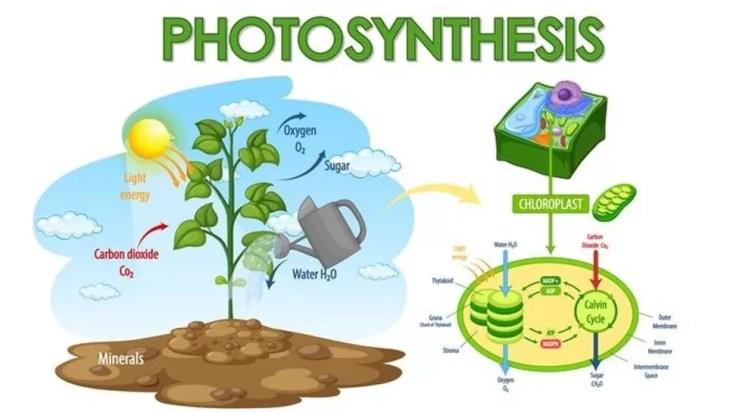Chapters
In this article, we will discuss the process of photosynthesis in plants in detail.
Unlike animals, plants have the ability to make their own food. They use a process known as photosynthesis to do so. During this process, plants generate glucose from carbon dioxide and water which are simple inorganic molecules using sunlight.

Definition
Photosynthesis is defined as:
"The process by which plants utilize sunlight, carbon dioxide, and water to create glucose and oxygen is known as photosynthesis"
Plants need the following things for carrying out the photosynthesis:
- Carbon dioxide from the air
- Chlorophyll (not used up)
- Water from the soil
- Light energy from the sun
As a result of the whole process, plants release the following substances which are quite beneficial for the plants and other organisms:
- Glucose which is a form of sugar
- Oxygen (released as a waste product)
Photosynthesis Equation
The following photosynthetic equation summarizes the entire process:
Carbon dioxide + Water  Sugar + Oxygen
Sugar + Oxygen
The balanced chemical equation of the above reaction is given below:

In the next section of the article, we will discuss the process of photosynthesis in detail.
Process of Photosynthesis
The chemical reaction of photosynthesis needs energy in the form of light. Photosynthesis is referred to as an endothermic reaction. The endothermic reaction refers to a chemical reaction in which heat energy is absorbed by the reactants to create products.
The leaves of the plant contain a green pigment known as chlorophyll. This green pigment plays a fundamental role in photosynthesis because it absorbs light energy from the sun. Chlorophyll is present in chloroplasts in the plants cells, especially the palisade and spongy mesophyll cells. Although plants leaves are the major photosynthetic organ, however, any portion of the plant that is exposed to sunlight will form chlorophyll and photosynthesize.
Plants also require carbon dioxide for photosynthesis which comes from its surrounding air. Carbon dioxide enters the plants leaves through a structure known as stomata. On the other hand, water enters the plants through their roots and is then carried to the leaves in the xylem.
The process of photosynthesis produces glucose and oxygen (as a byproduct). Some of the glucose is utilized for respiration, while some is stored in the form of starch. Later the stored starch can be turned back into glucose and utilized for respiration. Some of the oxygen produced by the process is utilized by the plant for respiration, while the remaining is released into the air where it becomes available to animals and many microorganisms for respiration. During the day time, sufficient light energy is available to the plants, therefore the rate of photosynthesis is quite high.

Summary of the process
In this section, we have summarized the entire process discussed above in three points:
- Chlorophyll in plants which is a green substance present in chloroplasts in the palisade cells in the leaf absorbs light energy from the sun
- The light energy absorbed by the chlorophyll is utilized to transform carbon dioxide (from air) and water (from soil) into a sugar known as glucose
- This process releases oxygen as a by-product
Investigating photosynthesis
In this section, we will discuss how to test if a plant is photosynthesizing. To determine this, we will conduct a test to see if starch is present in the plant's leaf. We already know that plants produce their food through photosynthesis. During the process, plants absorb light energy using chlorophyll. It enables the plants to convert carbon dioxide from air and water from the soil into glucose. Plants use this glucose to perform a variety of functions such as:
- Glucose is carried to the growing parts of the plants so that they can use it in respiration
- Converted into cellulose, oils, and proteins
- Stored in the form of starch so that later it can be turned back into glucose
Hence, to test whether the process of photosynthesis is occurring in the plant, it is essential to determine if starch is present in it.
Testing for Starch
One of the best ways to test for the presence of starch is to use an iodine solution. Follow the steps below to conduct an iodine solution test for the presence of starch:
Step 1 – Take a plant leaf and heat it in boiling water for 30 seconds. This step kills the leaf and stops any chemical reaction.
Step 2 – For some minutes, put the leaf to the boiling ethanol in a water bath. [Note that the boiling ethanol dissolves the chlorophyll and eliminates the green color of the plant leaf. The plant leaf turns white and it becomes easier to observe the change in color]
Step 3 – Wash the leaf with water to rehydrate and soften it. Place the lead on a white tile.
Step 4 – Use the dropping pipette to add an iodine solution and wait for a few minutes.
Result: After some minutes, the parts of the plant’s leaf where starch is present turns iodine from brown to black/blue.
Remember that variegated leaves contain a green and white part. Chlorophyll is present in the green part, while absent in the white part. Only the parts of the plant leaves that are green can turn blue or black with an iodine solution. This thing emphasizes the role of chlorophyll in photosynthesis. The white part of the leaf does not contain chlorophyll, therefore, it will not photosynthesize. If this part of the leaf will not photosynthesize, then it means that it will not make starch, and the iodine solution will have no impact on its color.
Limiting factors of photosynthesis
A limiting factor refers to any factor that slows down the rate of reaction. It is known as a limiting factor because it “limits” the reaction from taking place. Limiting factors of photosynthesis play a crucial role in greenhouses as they help to attain the maximum rate of photosynthesis and thus maximize profit. The following three factors affect the rate of photosynthesis and are therefore known as limiting factors:
- Light intensity: Without sufficient light, plants are not able to photosynthesize, even if plenty of carbon dioxide and water are available. Thus, to speed up the process of photosynthesis, sufficient light must be available to the plant.
- Carbon dioxide level: Plants require carbon dioxide to photosynthesize. Without sufficient carbon dioxide, plants are unable to carry out the process.
- Temperature: Extremely low and high temperatures affect the process of photosynthesis. If it is very cold, then the rate of photosynthesis becomes slow. On the other hand, in extremely hot conditions, the process of photosynthesis stops in plants.













i like the article
Hi Sam! Thank you! Great to hear that you found this resource useful.
welcome
Hi Suunu! Thanks for reaching out. Hope you’ve found this resource useful 😊!
i have learnt a lot which i did not know
am senior three student but this is cool
Am impressed
Am impressed
learning is the best
I like this one